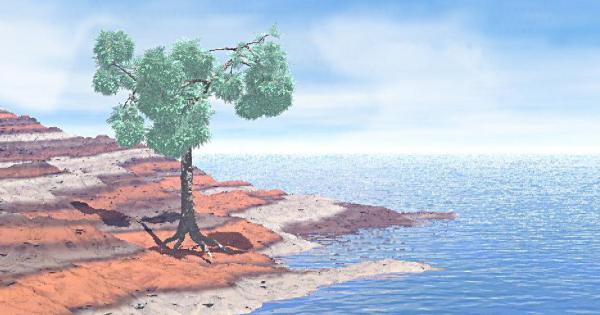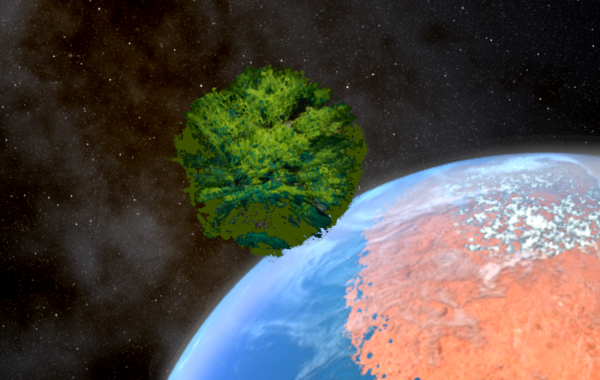BY LETTER
Plant
 Image from Steve Bowers | |
| Quercus novis, a tweaked oak tree species growing on Garrow, a partially terraformed colony in the Outer Volumes. Such plants help to stabilise the soil and maintain the oxygen balance. | |
In the strictest sense plants are any of a major group of related Old Earth organisms that are multicellular, eukaryotic, exhibit embryonic development and, except in a few parasitic forms, capable of photosynthesis via chloroplasts that bear chlorophylls a and b that give them their characteristic green colour. They are the primary producers in all of the terrestrial and many of the shallow aquatic ecosystems of their native planet.
In common parlance, a plant is any biological organism, Terragen or otherwise, and natural or otherwise, that is sessile, autotrophic and photosynthetic. Some xenologists and biologists prefer to reserve the term 'plant' exclusively for Terragen species which are members of the Kingdom Plantae, and invent alternative terms for other life forms, such as 'plant-like organism', 'plant analog', or 'plantoid'; others extend the classification 'plant' to cover similar xenobiont equivalents. In taxonomy, each separately-evolved biota on a life-bearing world may include a number of different groups of plant-like organisms, each with different characteristics and evolutionary history. These groups of plant-like organisms are each given specific taxonomical designations, and all naturally-evolved extraterrestrial plant-like organisms are completely distinct from Terragen plant groups.
Plant-like xenobiota, neogen, synano or cyborg organisms, particularly sessile and/or photosynthetic examples are generally referred to as plants in common parlance. Inorganic beings like plantbots are called plants only by analogy. There are similar disagreements regarding the nomenclature for sentient but subsophont neogen, synano, and cyborg organisms that resemble natural Terragen plants.
The major Terragen plant taxa are;
1/ Cyanobacteria of various sorts. These are not included in the major Terragen plant groups, but the photosynthetic organelles of all other plant groups are descended from various ancient species of Cyanobacteria which have become endosymbiotic within their cells. More details here.
2/ Algae, including Red Algae, Green Algae and Brown Algae. These range from single-celled organisms to large aquatic kelp. Note that from a cladistic viewpoint Red Algae and Brown Algae are distinct from Green Algae, which are included in the clade Viridiplantae with the other green plants. Many species of algae have been genegineered to produce foodstuffs, fuels, medicines, construction material and other useful products. The term 'algae' is also used in common parlance as a general designation for extraterrestrial organisms which fill similar ecological niches, and also for neogenic organisms, hylotech and synanotech microsystems that perform similar functions.
3/ Terragen land plants, including mosses, liverworts, lycophytes, ferns, gymnosperms and angiosperms. Representatives of all these groups can be found in artificial habitats and on terraformed worlds throughout the Terragen Sphere, often geneered or otherwise enhanced for various purposes.
Terragen land plants are distinguished from the algae that gave rise to them by embryological development and complex tissues, including reproductive organs that they evolved in adapting themselves for life out of the water. Though they lack the morphological and behavioural complexity of animals, plants are biochemically diverse; able to produce a wide variety of organic compounds. Plants comparable to mosses and liverworts first appeared in the late Ordovician, and colonized wet areas during the Silurian; by the late Devonian they had evolved the full suite of features necessary for life on land, and formed the first forests. Initially, lycopods, sphenophytes, and various ferns were predominant, but seed-bearing plants such as the cycads, gingkoes, conifers, gnetophytes, and angiosperms eventually came to dominate the flora. The angiosperms, or flowering plants, became common over the course of the Cretaceous, and accounted for the vast majority of species thereafter.
Well-known examples of xenobiota that are plant-like (and are often referred to as plants) can be found on Trees, Chorus, Ridgewell, on To'ul'h Prime (though in the atmosphere rather than on the surface), New Gaia, Oshiq, Kammerer, Dante, Ararat and other members of the Garden of Paradise cluster, and on the various Cybyotan worlds.
Lazurogenic projects have created reasonable facsimiles of most major extinct Terragen plants, though because of the fragmentary nature of plant fossils there is a large component of extrapolation and imagination in their re-creation. Still, groves or entire forests of cordaites, lepidodendrons, bennettites, glossopterids, calamites, and various extinct cycads, conifers, and gingkoes are quite common today.
 Image from LordOther and Steve Bowers | |
| An Orwood Dyson Tree orbiting the Mars-like planet Brick | |
Related Articles
- Akilaspek Trees
- Alseid
- Anchor Seed
- Angiosperm - Text by M. Alan Kazlev
In Terragen biology, a flowering plant in which the seeds are enclosed within an ovary which ripens into a fruit. Angiosperms are still the dominant type of terragen plant, with an estimated 250,000 baseline species, and literally hundreds of millions of neogen species. Their flowers are used in reproduction. Angiosperms evolved 125 million years ago, during the early Cretaceous period. - Autotroph - Text by M. Alan Kazlev
An organism that produces its own food from light or chemical energy and/or inorganic matter. Also called a Producer (or Primary Producer). Among terragen life forms, most green plants, many protists, and many prokaryotes are autotrophs. There are also alife and informational autotrophs/producers. Every food chain rests on autotrophs. Autotrophs in turn provide food for heterotrophs. - Bennettitale
- Bradychronic Plant Provolves
- Canopy Plant
- Cyanobacteria
- Deliplants
- Dendrosequoia sapiens
- Devil's Rose
- Dura Grass
- Epiphyte - Text by M. Alan Kazlev
A plant (or sometimes other organism) that lives attached to a larger plant or a structure like a tower or a building. Epiphytes acquire water and nutrients from the air. - Ethnobotany - Text by M. Alan Kazlev
Study of how plants are used in various (mostly prim, neo-prim, or bioborg) hu, tweak, splice, provolve, and xenosophont cultures. - Fern
- Flera
- Forest - Text by M. Alan Kazlev
Any biome type involving a dense concentration of trees or analogous neogens or xenophyta, distributed over a large area of land. In some biomes, such as rainforest, there are a number of distinct levels, such as canopy and forest floor, each with their distinct micro-ecologies. - Forest Floor - Text by M. Alan Kazlev
The lowest layer of a rainforest, extending from the ground to about a meter in height. This layer is teeming with animal life, including insects, mammals, and ground birds. - Ginkgo
- Glow-Orb Cactus
- Gourd Houses
- Gymnosperm - Text by M. Alan Kazlev and Stephen Inniss
Terragen seed-bearing plants in which the seeds develop without a protective covering derived from the ovaries. In short, any seed-bearing plant that is not an angiosperm. They release pollen into the air to the female ovule, causing fertilization. Gymnosperms include seed ferns, conifers, ginkgoes, and cycads. Conifers were the only common gymnosperms by the time humanity arose on Old Earth, but many other kinds of gymnosperm have since been lazurogened. - Keruing, Clade
- Lantern Plant
- Lycopod
- Noovleann Tree
- Orwoods (Dyson Trees)
- Plantbots
- Plastid - Text by M. Alan Kazlev
A cell-body (organelle) found in Terragen plants and algae. In plants, any type of plastid can transform into another, making them popular among some gengineers. Their shape and function differs. For example, proplastids develop into leukoplasts which develop to chloroplasts and/or chromoplasts for photosynthesis. They have their own DNA (ctDNA) and ribosomes due to their origin as symbiotic cyanobacteria. - Road Root
- Skywracks
- Turbine Plants
Appears in Topics
Development Notes
Text by Stephen Inniss
Additional material by Steve Bowers 2024
Initially published on 20 November 2010.
Additional material by Steve Bowers 2024
Initially published on 20 November 2010.






